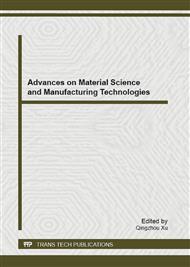[1]
Herman J., Woerdenbag, Jos F. J. Lüers,Wim Uden,. Production of the new antimalarial drug artemisinin in shoot cultures of annua L.[J]. Journal of Plant Cell, Tissue and Organ Culture, 32(2) (1993)247-257.
DOI: 10.1007/bf00029850
Google Scholar
[2]
ZQ Wei, CD Li,JY Xiao. Study on the Planting Technology of annua L. Journal of Chin Med J Res Prac, 25(2)(2011)6-8.
Google Scholar
[3]
ZQ Wei, CD Li,JY Xiao , Effects of Fertilizing Levels on Output and Quality of Artem isia annua L. Journal of LISH IZHEN MEDIC INE AND MATERIA M ED ICA RESEARCH 19(5) (2008)1286-1287.
Google Scholar
[4]
WD Zhang. "The Utilization of Malignant Poisonous Weeds-Eupatorium adeno phorum", Journal of Yunnan Forestry and Technology, 74(1996) 78-81.
Google Scholar
[5]
YQ Shao, QIU Ling, Potential of the Biogas Fermentation of Rumex L. Journal of Acta Agricultur and Bor eali-occidental is Sinica, 20(1) (2011) 190-193.
Google Scholar
[6]
RH Liu, YY Wang, C Sun, Experimental study on biogas production from vegetable waste by anaerobic fermentation, Transactions of the CSAE, 209-213.
Google Scholar
[7]
XH Shao, NS Xu, LX Cai, Discussion on energy conversion efficiency of biogas fermentation, Journal of China Biogas, 3(1984)40-43.
Google Scholar
[8]
YM Xu, WD Zhang, R Xu, Study on the potential of biogas production from grape seed by anaerobic digestion before and after oil-extracting, Journal of Renewable Energy Resources, 29(2)(2011)78-80.
Google Scholar
[9]
F Yin, M Huang, R Xu, WD Zhang, Analysis on Eupatorium Hazards and Development in its Comprehensive Utilization, Journal of Catastrophology, 24(2009) 63-67.
Google Scholar
[10]
XJ Wang, GK Zeng, SQ Liu, Study on Biogas Fermentation of Corncob,Anhui Agricultural Science Bulle, .12(200)55-57.
Google Scholar
[11]
YH Jiang, WD Zhang, LM Gu, A Experimental Study on Extended Retention Time of Methane Fermentation Using Eupatorium adenophorum Spreng, Journal of Yunnan University, 11(1989)51-55.
Google Scholar
[12]
P.C. Hallenbeck, Fundamentals of the fermentative production of hydrogen, England, Water Sci &Technol, 52(112) (2005) 21-29.
Google Scholar
[13]
P.C. Hallenbeck, J.R. Benemann. Biological hydrogen production fundamentals and limiting processes, England, Intern J Hydrogen Energy, 27(11)(2002) 1185-1193.
DOI: 10.1016/s0360-3199(02)00131-3
Google Scholar
[14]
BF Xie , J Cheng, JH Zhou, Cogeneration of hydrogen and methane from glucose to improve energy conversion efficiency, England, Intern J Hydrogen Energy,33(19) (2008) 5006-5011.
DOI: 10.1016/j.ijhydene.2008.07.048
Google Scholar
[15]
DW Liu, DP Liu, Raymond J Zeng, Hydrogen and methane production from household solid waste in the two-stage fermentation process", England, Water Research, 40(2006)2230-2236.
DOI: 10.1016/j.watres.2006.03.029
Google Scholar
[16]
CY Lin, RC Chang. hydrogen production during the anaerobic acidogenic conversion of glucose,England, J Chem Technol Biotechnol,74(1999) 498-500.
DOI: 10.1002/(sici)1097-4660(199906)74:6<498::aid-jctb67>3.0.co;2-d
Google Scholar
[17]
R .Thauer, K. Jungerman and K. Decker, "Energy conservation in chemotrophic anaerobic bacteria", Bacteriol Rev, 41(1) (1977) 100-180.
DOI: 10.1128/br.41.1.100-180.1977
Google Scholar
[18]
D LI, ZH Yuan, YM Sun, Sequential Anaerobic Fermentative Production of Hydrogen and Methane from Organic Fraction of Municipal Solid Waste, China, Chin J Appl Environ BioI, 15(2)(2009) 250-257.
DOI: 10.3724/sp.j.1145.2009.00250
Google Scholar
[19]
J. J. Lay, Biohydrogen generation by mesophilic Anaerobic fermentation of microcrystalline cellulose, America, Biotechnology and bioengineering, 74(4) (2001) 280-287.
DOI: 10.1002/bit.1118
Google Scholar
[20]
J. J. Lay, Modeling and optimization of anaerobic digested sludge converting starch to hydrogen, America, Biotechnology and Bioengineering, 68(3)(2000) 269-278.
DOI: 10.1002/(sici)1097-0290(20000505)68:3<269::aid-bit5>3.0.co;2-t
Google Scholar
[21]
V. Lina, K. Anna, Optimising hydrogen production from anaerobic digestion of food industry residues and manure. Proceeding of Biohydrogen 2002, The Netherlands: Link Springs Universitet Press, (2002)35-40.
Google Scholar
[22]
M. Osamu, D. Hawkes, F. R. Hawkes, Enhancement of hydrogen production from glucose by nitrogen gas sparging. England, Bioresource Technology,73(2000)59-65
DOI: 10.1016/s0960-8524(99)00130-3
Google Scholar


